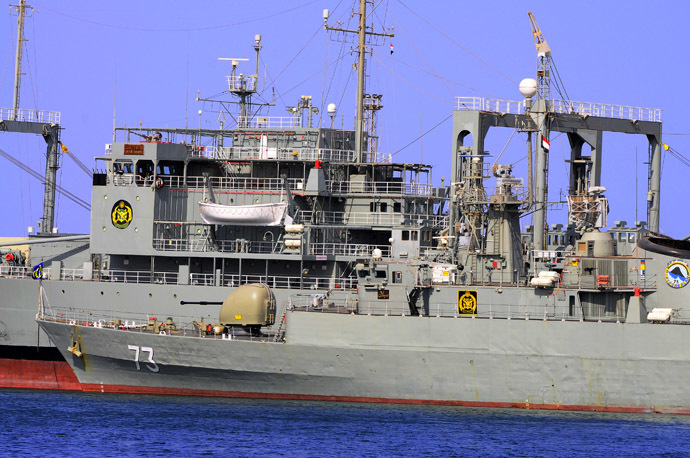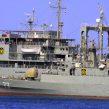
Iranian Naval Adventurism in the Atlantic Ocean
Publication: Terrorism Monitor Volume: 12 Issue: 4
By:

Iran’s Navy Commander, Admiral Habibollah Sayari, announced on January 21 that Iran’s 29th fleet had left the port of Bandar Abbas for a three-month mission to the Atlantic Ocean (Press TV [Tehran], January 22). The 29th fleet consists of only two 1970s vintage British-built ships, the supply ship Kharg (refitted in 1994 and capable of supporting three Sea King helicopters) and the Alvand class frigate Sabalan (usually described as a helicopter carrier and a destroyer respectively by Iranian authorities). Though the Kharg is the larger ship, it is essentially acting as a support ship for the Sabalan.
The navy sent the warships, according to Admiral Sayari, to provide security for Iranian ships in international waters, particularly near the U.S. maritime border, and to “send a message of peace and friendship to world countries” (Fars News [Tehran], January 21; Press TV, January 22). On February 9, Admiral Afshin Rezaei Haddad made a follow-up announcement, stating that the 29th fleet had already reached South Africa and entered the Atlantic Ocean (Press TV, February 9; Fars News February 9). For the first time, Rezaei claims, the Iranian military is establishing a presence near American territory (Press TV, February 9).
For the most part, Tehran argues that the decision to deploy the fleet is part of a military response to Washington building naval presence in the Persian Gulf in recent years. The American military presence in the Persian Gulf has primarily involved the Navy’s 5th fleet based in Bahrain, 153 miles away from the Iranian mainland. American ships have conducted two major maritime war games with Iran’s Arab neighbors since 2012 (Fars News, February 8; Seratnews.ir, February 9). The military build-up has also included the participation of NATO member countries such as France in war games, raising fears in Tehran of a major military assault, particularly against its nuclear facilities (Press TV, February 5).
For Iranians, the best way to deal with the American threat in the Persian Gulf is to confront it with regular military exercises. On one level, the expansion of naval and ballistic war game operations in the Persian Gulf since 2008 has played a key role in the Islamic Republic’s projection of power against the American presence near its maritime borders (see Terrorism Monitor, November 4, 2011). On another level, the deployment of Iranian warships to places such as the Gulf of Aden in November 2008 (for anti-piracy missions) and the Suez Cannel for a visit to a Syrian Mediterranean port has served to display Iran’s military capabilities “in confronting any foreign thereat on the country’s shores” (IRNA March 5, 2011; for other Iranian naval operations, see Terrorism Monitor Briefs, October 1, 2009; Terrorism Monitor July 29, 2010 and Terrorism Monitor Briefs, March 10, 2011).
However, it is the Persian Gulf that remains the main defensive line for Iran. This is so since, Tehran argues, the United States views the Gulf not just as a security zone but also an extension of its maritime territories. The commander of the Iranian Revolutionary Guards’ Corps (IRGC) Navy (a small-boat naval force operating as a parallel force with the Iranian Navy), Rear Admiral Ali Fadavi, articulated this perception in his assertion that for the United States, “the Persian Gulf is the only part of the world for which Americans use the phrase ‘vital national security interests.’ It is the phrase that they only use for their homeland and the Persian Gulf” (Fars News, January 29).
Iran’s February announcement of a new line of “smart combat vessels” highlights Tehran’s continuous effort to display its naval strength (Press TV, January 11, 2013; February 9; Mehr News [Tehran], February 9). In this way, Iran’s strategy involves engaging in psychological warfare, or what the Iranian state calls “soft war,” with the aim of framing the ineffectiveness of enemy abilities and the neutralization of enemy military strategy on both the operational and public policy levels (for the “soft war” concept, see Terrorism Monitor, June 12, 2010). This type of psychological strategy revolves largely around the construction of hyped statements that can be used both for propaganda purposes and to undermine enemy strength. It is in fact highly unlikely that the Iranian vessels are heading to the U.S. coast as declared, especially since it is difficult to send such aging ships to sea for such an extended voyage (Jamnews, February 9). In light of superior American naval power, Iran’s best chance to wage effective naval combat is to rely on asymmetrical naval warfare in home waters, the specialty of the IRGC Navy. The rough waters of the North Atlantic might be the worst geo-military space to show off whatever naval power Iran might have.
At the heart of every military operation lies politics. It should hardly be a surprise that the warships’ voyage to the Atlantic comes amidst the ongoing nuclear negotiations between Iran and the P5+1 group in Geneva, with the latest talks scheduled to begin on February 18. While the administration of President Hassan Rowhani has suspended 20 percent enrichment of its uranium (the level that would enhance Tehran’s capability of producing fuel for atomic weapons), the hardline factions of the theocratic-military state apparatus have reacted strongly to the interim nuclear deal reached last November. Despite the blessing of Supreme Leader Ayatollah Ali Khamenei for the agreement, the hardliners are working to delegitimize the deal, which they see as a sign of defeat at the hands of the world’s superpowers. Rowhani’s recent halt of a scheduled missile exercise has caused additional anger in the anti-diplomacy camp of Iranian politics. By deploying (or announcing the deployment) of the warships to waters off the American coast, the hardline factions seem eager to provoke the United States into reacting in a more confrontational manner, preventing the progress of diplomatic talks (al-Jazeera, February 9).
The current naval deployment also takes place during an ongoing push by the Islamic Republic to demonstrate Iran’s ability to project military power in the Gulf region and beyond. The deployment most certainly has the approval of the Supreme Leader, who has the ultimate authority to initiate such military operation and most likely believes that Iran must also project strength through military might during the ongoing nuclear negotiations.
While such projections could be viewed as a way to warn the United States against a possible military strike in case negotiations fail, in reality the move is designed to display Iranian power for domestic consumption. Far from Iran seeking “worldwide ambitions and capabilities,” as Chris Harmer of the Institute for the Study of War has suggested (USA Today, February 10), the main target of the latest naval spectacle is the Iranian people, in particular the hardline base that continues to see the deal as a sign of weakness. What the naval adventure into the Atlantic really displays is how Iran can continue to taunt its powerful American rival in oceanic territories near the enemy’s homeland.
Nima Adelkhah is an independent analyst based in New York. His current research agenda includes the Middle East, military strategy and technology, and nuclear proliferation among other defense and security issues.





